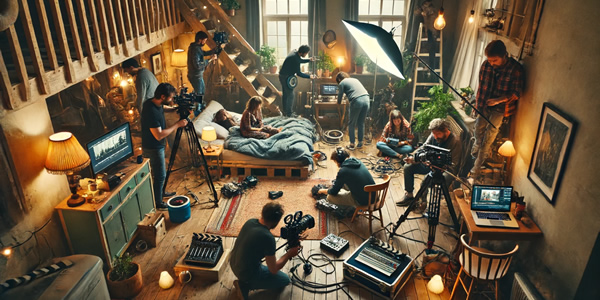Understanding Micro-Budget Feature Films By South Wales Video
In filmmaking, terms like “blockbuster” and “indie film” are commonly thrown around, but one category that often sparks curiosity is the “micro-budget feature film.” Let’s explore what a micro-budget feature film truly entails, why it holds significant potential in today’s digital age, and why horror is the best genre to explore.
What Defines a Micro-Budget Feature Film?
A micro-budget feature film is typically produced with a significantly lower budget than mainstream or even standard independent films. While there’s no universally agreed-upon financial threshold, these films are usually made with a budget under £100,000. The emphasis is on maximising creativity and resourcefulness to produce a high-quality film despite financial constraints.
Digital Technology: Leveling the Playing Field
Advancements in digital technology have revolutionised filmmaking, making it more accessible than ever. High-quality digital cameras, affordable editing software, and online distribution platforms have dramatically lowered the barriers to entry. Filmmakers no longer need vast sums of money to create visually compelling films. This technological shift has effectively levelled the playing field, allowing micro-budget films to compete with larger productions.
The Economic Viability of Micro-Budget Films
Micro-budget films have a unique advantage: they are more likely to turn a profit. With lower production costs, the break-even point is much easier to reach. Here are a few reasons why micro-budget films can be financially viable:
- Cost Efficiency: By cutting corners where possible, such as using natural light instead of expensive lighting rigs or shooting in public spaces rather than renting studios, costs are kept to a minimum.
- Deferred Payments: Offering deferred payments and profit-sharing agreements can attract passionate talent willing to invest their time and skills in exchange for a potential return.
- Script Writing: Crafting scripts that utilise available resources, such as locations and props, helps keep expenses down. Writing scenes that can be filmed in one location or with minimal setup can significantly reduce costs.
Resourcefulness and Speed
Micro-budget filmmaking is all about working smart and fast:
- Using Available Resources: Leveraging what’s readily available, from locations to props, can make a significant difference.
- Aspiring Talent: Aspiring actors and crew members are often eager to work on micro-budget films to gain experience and build their portfolios. Their passion and willingness to contribute can elevate the production.
- Rapid Production: Shorter shooting schedules necessitate thorough planning and efficient execution. This urgency often brings out the best in cast and crew, driving them to work creatively within constraints.
Popularity and Accessibility
Micro-budget films have become increasingly popular in recent years, especially with the rise of streaming platforms like Amazon Prime. I personally love to watch them; while some might be better than others, there’s always something creative to take away. These films often feature fresh and innovative storytelling that can surprise and inspire viewers. Many films today are even featuring public domain characters with a horror twist, showcasing the inventive ways filmmakers can reimagine classic tales.
Why Horror is the Best Genre for Micro-Budget Films
Horror is arguably the best genre to explore for micro-budget filmmakers. Here’s why:
- Market Friendly: Horror films have a huge, dedicated fan base that is always eager for new content. They tend to perform well at the box office and on streaming platforms, making them more likely to turn a profit.
- Minimalist Approach: Horror often relies on atmosphere, tension, and psychological elements rather than expensive special effects. This makes it easier to produce high-quality horror films on a tight budget.
- Creativity Over Cost: The genre allows for creative storytelling and innovative scares that don’t require a large financial investment. Clever use of sound, lighting, and camera angles can create a chilling experience.
- Public Domain Characters: Reimagining public domain characters with a horror twist adds a unique hook that can attract audiences. These familiar yet fresh stories can be a goldmine for low-budget filmmakers.
Recent Successes
Recent micro-budget horror films like “Winnie-the-Pooh: Blood and Honey” have shown just how profitable this approach can be. Made on a modest budget of just £20,000 in 6 days. this film turned a substantial profit in the millions, demonstrating the potential of leveraging well-known characters in creative new ways.
Conclusion
Micro-budget filmmaking is a testament to the power of creativity, determination, and passion. With digital technology levelling the playing field and a strategic approach to budgeting and production, micro-budget films offer a viable path to both artistic and financial success. Whether you’re an aspiring filmmaker looking to make your mark or a film lover eager to explore new narratives, understanding the essence of micro-budget films opens a door to a realm where resourcefulness and ingenuity reign supreme.
Ready to start your own filmmaking journey? We’re making a film in South Wales. Stay tuned to MJ Films for more insights, tips, and inspiration from the cinematic landscape. There’s a wealth of creativity waiting to be discovered, and it’s more accessible than ever before.

